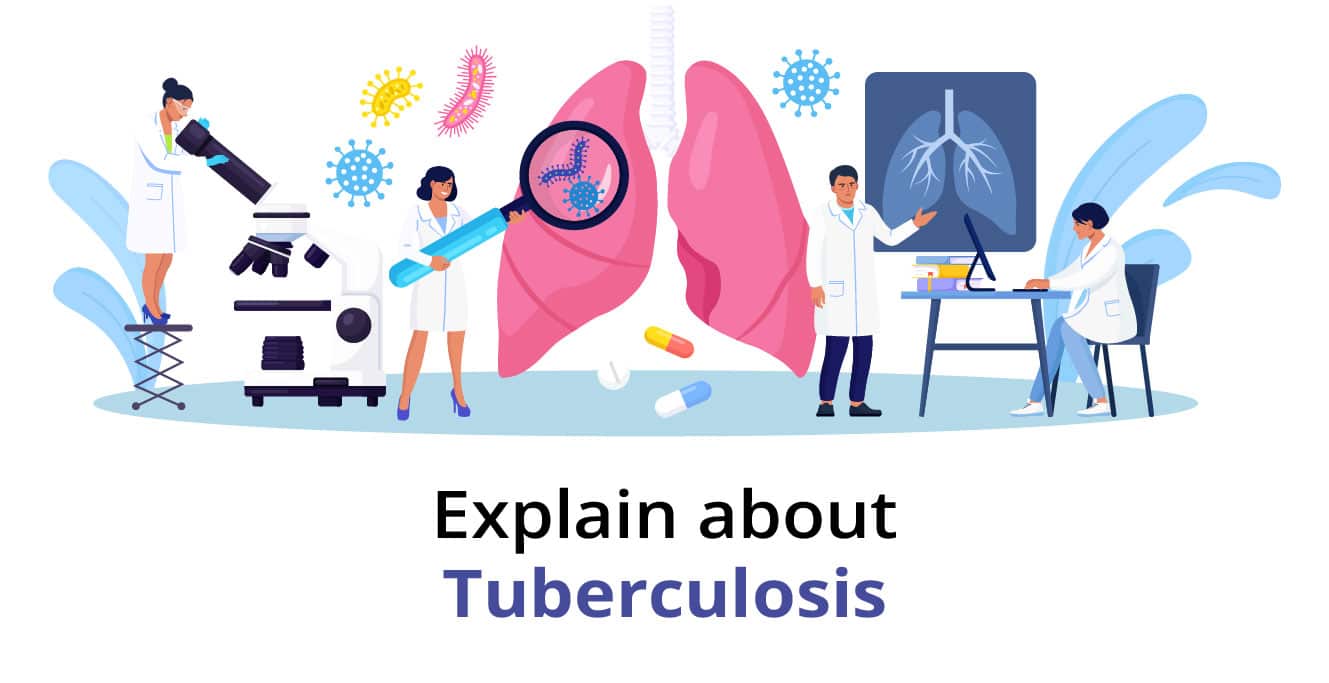
Types of Tuberculosis

Table of Contents
Tuberculosis (TB) is a disease caused by a bacterial infection. While it usually affects the lungs, it can also affect other body parts, such as the brain and spine. There are different types of TB.
Keep reading to learn more about what the tuberculosis types are.
What are the different types of tuberculosis?
The two main tuberculosis types are active and latent tuberculosis.
Active tuberculosis results in certain symptoms. The symptoms depend on where the infection spreads and which body parts are affected. The different types of TB are determined based on the affected body parts.
Before delving into the types, let us first understand what is active and latent tuberculosis.
Active and latent types of TB
These tuberculosis types are based on whether there is an active infection with symptoms or an inactive presence that does not result in symptoms.
Active tuberculosis
Active tuberculosis is when the TB bacteria multiply in your body and result in active symptoms of tuberculosis. Active TB is infectious; if you have it, you can spread it to others.
The general symptoms of this tuberculosis type would include:
- Sudden loss of appetite
- Fever and/or chills
- Night sweats
- Weakness or tiredness
- Weight loss without any explainable cause
Latent tuberculosis
Latent tuberculosis is a condition in which you have a TB infection, but the TB bacteria stays inactive or dormant in your body. It does not result in any symptoms.
Although the bacteria may be residing inside your body, your immune system helps prevent them from affecting your body. However, you will test positive for TB blood and skin tests.
In certain rare cases, latent TB can turn into active TB.
Tuberculosis types based on the affected body part
As mentioned earlier, there are different types of TB based on where the active infection manifests and causes symptoms. These are explained below:
Pulmonary tuberculosis
This type of TB involves active TB that affects a person’s lungs. It is the most commonly understood form of tuberculosis. You can get the infection by inhaling air that contains the infection, exhaled by someone who has TB.
The symptoms include:
- A persistent cough lasting for more than a few weeks
- Coughing up blood or phlegm
- Pain in the chest
- Breathing difficulty or shortness of breath
Extrapulmonary tuberculosis
This type of TB affects parts of the body besides the lungs. The symptoms differ based on which part of the body is affected. The types of TB (extrapulmonary) are explained below.
Tuberculosis Lymphadenitis
This is one of the common types of TB, and it affects the lymph nodes. Symptoms of lymphadenitis may include swollen lymph nodes, often in the neck. Apart from this, it also causes the general symptoms of active tuberculosis.
Skeletal Tuberculosis
This is one of the less common tuberculosis types, and it affects the bones in your body. It is also known as bone TB.
While it may not result in symptoms at the start, it can eventually lead to general symptoms of TB. It can also cause:
- Severe back pain (if it affects the spine)
- Stiffness or pain in the joints
- Development of abscesses (masses of skin tissue)
- Deformities in the bones
Gastrointestinal Tuberculosis
This is one of the active types of TB that affects the gastrointestinal tract, including different organs and parts of the digestive system. Symptoms include:
- Pain in the abdomen
- Sudden loss of appetite
- Abnormal loss of weight
- Bowel issues like constipation or diarrhoea
- Nausea
Genitourinary Tuberculosis
This tuberculosis type affects parts of the genitals or the urinary tract. It is one of the most common types of TB. It can affect different organs but often affects the kidneys the most.
The symptoms may include:
- Development of a TB ulcer on the genitals or in the genital tract
- Swelling of parts of the genitals
- Pain when passing urine
- Issues with urine flow
- Pain in the pelvic region
- Reduced quantity of semen
- Reduced fertility or infertility
Liver Tuberculosis
This is one of the rarer types of TB. It affects the liver and is also known as hepatic tuberculosis.
Its symptoms include:
- High fever
- Pain in the area around the liver or the upper abdomen
- Swelling of the liver
- Jaundice
Meningeal Tuberculosis
This is also called TB meningitis. It affects the meninges, which are the layers of membranes that cover and protect the brain and spinal cord. One of the active tuberculosis types, it is gradual in its development.
The initial symptoms usually include:
- Aches and pains
- Weakness and tiredness
- Headache that persists
- Fever
- Nausea
As it develops further, the symptoms may include:
- Severe headaches
- Stiffness in the neck
- Light sensitivity
Tuberculosis Peritonitis
This is one of the active types of TB, and it causes inflammation of the peritoneum. The peritoneum is a layer of tissue lining the abdomen and most of the organs in it. It can lead to a collection or buildup of fluid in the abdomen known as ascites.
Other symptoms may include nausea, vomiting, and appetite issues.
Military Tuberculosis
This is one of the active tuberculosis types and spreads across the body. It usually affects more than one organ. It causes general TB symptoms as well as more specific symptoms that arise from the parts of the body it affects.
It can often manifest in the lungs, bones, and liver. However, it can also affect other organs and bones, such as the spinal cord, heart, and brain. For example, if it affects the spinal cord, you may experience back pain or stiffness.
Tuberculosis Pericarditis
TB pericarditis is one of the tuberculosis types, and it affects the pericardium. This refers to the layers of tissue that surround the heart and contain fluid between them.
Symptoms of TB pericarditis include the following:
- Pain in the chest
- Fever
- Tremours
- Cough
- Difficulty breathing smoothly
Cutaneous Tuberculosis
Cutaneous TB is one of the rarer types of TB. It affects the skin, the largest organ in our body, and other body parts.
The main symptoms of this type of TB are sores or lesions that develop on the skin. It can also result in small bumps that are flat or raised like warts. It may result in ulcers and abscesses too.
They can develop in different areas, such as around the hands, feet, arms, buttocks, and behind the knees.
Conclusion
Active tuberculosis types can affect different parts of your body as the infection spreads.
Further, certain types of TB can affect vital body parts like the brain and lungs and other body parts like the genitals. This can impact your overall health and also affect your fertility.
If you or your partner are concerned about fertility, it is best to visit a fertility specialist. For the best fertility consultation, treatment and care. Visit the nearest Birla Fertility and IVF Clinic or book an appointment with Dr. Deepika Mishra to put your doubts to rest.
FAQs
1. What are the 5 causes of tuberculosis?
The 5 risk factors that can cause tuberculosis are as follows:
1) A weakened immune system
2) Substance abuse
3) Organ transplants
4) HIV infection
5) Exposure to someone who has the infection
2. What causes tuberculosis?
The bacterium Mycobacterium tuberculosis causes tuberculosis. The infection spreads through the air. It is usually contracted by exposure to a person who has the infection, by breathing in the air they exhale.
3. What happens if you get tuberculosis?
If you get tuberculosis, the infection may stay inactive in your body or become an active infection. In active TB, the infection starts to affect your lungs and may also affect other body parts. It can be a fatal disease if not treated.
Our Fertility Specialists
Related Blogs
To know more
Birla Fertility & IVF aims at transforming the future of fertility globally, through outstanding clinical outcomes, research, innovation and compassionate care.
Had an IVF Failure?
Talk to our fertility experts

 Our Centers
Our Centers








